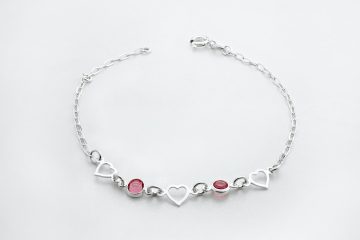If you’re a fan of unique and stylish accessories, you’ve probably come across clay bead bracelets. These handcrafted pieces of jewelry have gained popularity due to their versatility and personalized touch. The art of crafting clay bead bracelets requires skill, creativity, and patience. In this article, we will dive into the fascinating world of clay bead bracelet making, exploring the intricate process and the time it takes to create a masterpiece.
Understanding the Basics of Clay Bead Bracelet Making
Before we delve into the time it takes to create clay bead bracelets, let’s understand the basics of this art form. Clay bead bracelets are made by shaping and molding clay into small beads. These beads are then baked or cured to harden them, creating durable and long-lasting jewelry.
1. Selecting the Right Clay
The first step in creating clay bead bracelets is selecting the right type of clay. There are various types of clay available, such as polymer clay, air-dry clay, and porcelain clay. Each type has its own characteristics and working properties, so it’s important to choose one that suits your project and preferences.
2. Designing the Beads
Once you have selected the clay, it’s time to design the beads. This is where your creativity comes into play. You can experiment with different shapes, sizes, and patterns to create unique and eye-catching beads. Some artists even incorporate textures or add intricate details to their beads, making each piece one-of-a-kind.
The Time-Intensive Process of Clay Bead Bracelet Making
Crafting clay bead bracelets is a labor-intensive process that requires attention to detail and precision. Let’s break down the various stages involved, understanding the time it takes to create a masterpiece.
3. Conditioning the Clay
Before you can start shaping the beads, the clay needs to be conditioned. Conditioning involves kneading and warming the clay to make it pliable and easy to work with. This step ensures that the clay is free from air bubbles and ready for shaping. Depending on the size of the project, conditioning the clay can take anywhere from a few minutes to half an hour.
4. Shaping the Beads
Once the clay is conditioned, it’s time to shape the beads. This can be done by hand or by using tools such as bead rollers or molds. Shaping the beads requires patience and precision, as you strive for consistent sizes and shapes. The time it takes to shape each bead varies depending on its complexity and intricacy. On average, shaping a single bead can take anywhere from a few minutes to fifteen minutes.
5. Baking or Curing the Beads
After the beads are shaped, they need to be baked or cured to harden them. The baking or curing process depends on the type of clay you are using. Polymer clay, for example, needs to be baked in an oven at a specific temperature for a certain amount of time. Air-dry clay, on the other hand, can be left to air dry and harden naturally. The baking or curing time can range from 10 minutes to an hour, depending on the type of clay and the size of the beads.
6. Sanding and Polishing
Once the beads are hardened, they may require sanding and polishing to achieve a smooth and professional finish. Sanding helps remove any imperfections or rough edges, while polishing adds shine to the beads. This step can be time-consuming, especially if you are working with a large number of beads. It may take several minutes to an hour to sand and polish a batch of beads, depending on their size and condition.
7. Assembling the Bracelet
Finally, after all the beads have been shaped, baked, and polished, it’s time to assemble the bracelet. This involves stringing the beads onto a cord or wire, adding any additional components such as clasps or charms, and securing everything in place. Assembling the bracelet can take anywhere from a few minutes to half an hour, depending on the complexity of the design and the number of beads.
Conclusion
Crafting clay bead bracelets is a captivating art form that requires time, skill, and dedication. From selecting the right clay to assembling the final piece, each step in the process contributes to the creation of a unique and beautiful masterpiece. The time it takes to create a clay bead bracelet varies depending on factors such as the size of the project, the complexity of the design, and the artist’s skill level. However, the effort and time invested in this art form are undoubtedly worth it when you see the final result – a stunning piece of jewelry that reflects your creativity and personal style.
FAQs (Frequently Asked Questions)
Q1: Can I mix different types of clay to create clay bead bracelets?
Yes, you can mix different types of clay to create unique bead designs. However, it’s important to ensure that the clays you are mixing have compatible baking or curing temperatures and times.
Q2: How can I add color to my clay beads?
You can add color to your clay beads by using various techniques such as painting them with acrylic paints, applying alcohol inks, or mixing colored clays. Experimenting with different coloring methods can add vibrancy and visual interest to your bead designs.
Q3: Are clay bead bracelets durable?
Yes, clay bead bracelets can be quite durable, especially if they are properly baked or cured. However, it’s important to handle them with care and avoid exposing them to excessive moisture or high temperatures, as this can affect their longevity.
Q4: Can I personalize clay bead bracelets with names or initials?
Certainly! Personalizing clay bead bracelets with names or initials is a popular trend. You can use small letter stamps or molds to imprint names or initials onto the beads before baking or curing them.
Q5: Can I make clay bead bracelets without baking or curing?
Yes, if you prefer not to bake or cure the clay, you can use air-dry clay. Air-dry clay hardens naturally when left to dry in the air, eliminating the need for baking. However, keep in mind that air-dry clay may have different working properties compared to baked clays, so it’s important to follow the manufacturer’s instructions.




